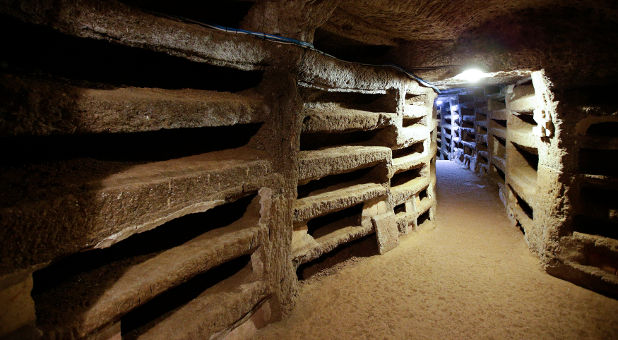Do Restored Frescoes Confirm Female Priesthood or Illustrate Fairy Tale?
Proponents of a female priesthood say frescoes in the newly restored Catacombs of Priscilla prove there were women priests in early Christianity. The Vatican says such assertions are sensationalist “fairy tales.”
The catacombs, on Rome’s Via Salaria, have been fully reopened after a five-year project that included laser technology to clean some of the ancient frescoes and a new museum to house restored marble fragments of sarcophagi.
Art lovers and the curious around the world who cannot get to Rome can join the debate by using a virtual visit to the underground labyrinth by Google Maps, a first-time venture mixing antiquity and modern high technology.
Built as Christian burial sites between the second and fifth centuries and meandering underground for 13 km (8 miles) over several levels, the Catacombs of Priscilla contain frescoes of women that have provoked academic debate for many years.
One, in a room called the “Cubiculum of the Veiled Woman,” shows a woman whose arms are outstretched like those of a priest saying Mass. She wears what the catacombs’ Italian website calls “a rich liturgical garment.” The word liturgical does not appear in the English version.
She also wears what appears to be a stole, a vestment worn by priests. Another fresco, in a room known as “The Greek Chapel,” shows a group of women sitting around a table, their arms outstretched like those of priests celebrating Mass.
Organizations promoting a female priesthood, such as the Women’s Ordination Conference and the Association of Roman Catholic Woman Priests, have pointed to these ancient scenes as evidence of a female priesthood in the early Church.
But the Vatican contests these interpretations which have also appeared in books on women in Christianity, such as the The Word According to Eve published in 1998.
“This is an elaboration that has no foundation in reality,” Barbara Mazzei of the Pontifical Commission on Sacred Archaeology told Reuters at the presentation of the restoration on Tuesday.
“This is a fairy tale, a legend,” said Professor Fabrizio Bisconti, superintendent of religious heritage archaeological sites owned by the Vatican, including numerous catacombs scattered around Rome.
He said such interpretations were “sensationalist and absolutely not reliable.”
Bisconti said the fresco of the woman in a gesture of priest-like prayer was “a depiction of a deceased person now in paradise,” and that the women sitting at the table were taking part in a “funeral banquet” and not a Eucharistic gathering.
The Church teaches that women cannot become priests because Jesus willingly chose only men as His apostles.
Giorgia Abeltino, head of public policy at Google Italy, said special instruments and smaller cameras were developed for the virtual tour project, which is similar to Google’s street view except that it explores the bowels of ancient Rome.
The Catacombs of Priscilla are also famous for a fresco which experts believe is the oldest known image of the Madonna and Child, dating to about 230 AD.
Lost for centuries after its entrances were sealed in ancient time, the catacombs were re-discovered in the 16th century and plundered of many gravestones, sarcophagi and bodies. Excavations in modern times began in the 19th century.
Reporting By Philip Pullella; Editing by Michael Roddy and Angus MacSwan
© 2013 Thomson Reuters. All rights reserved.
















































